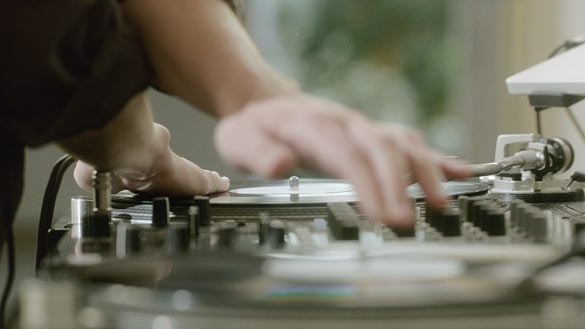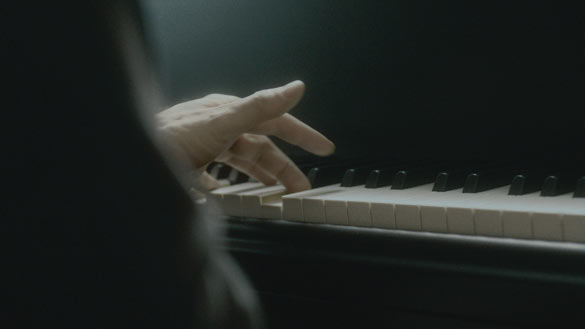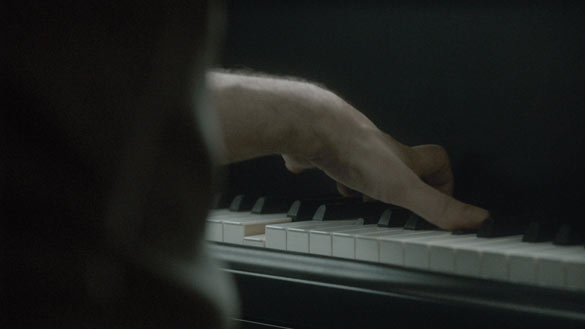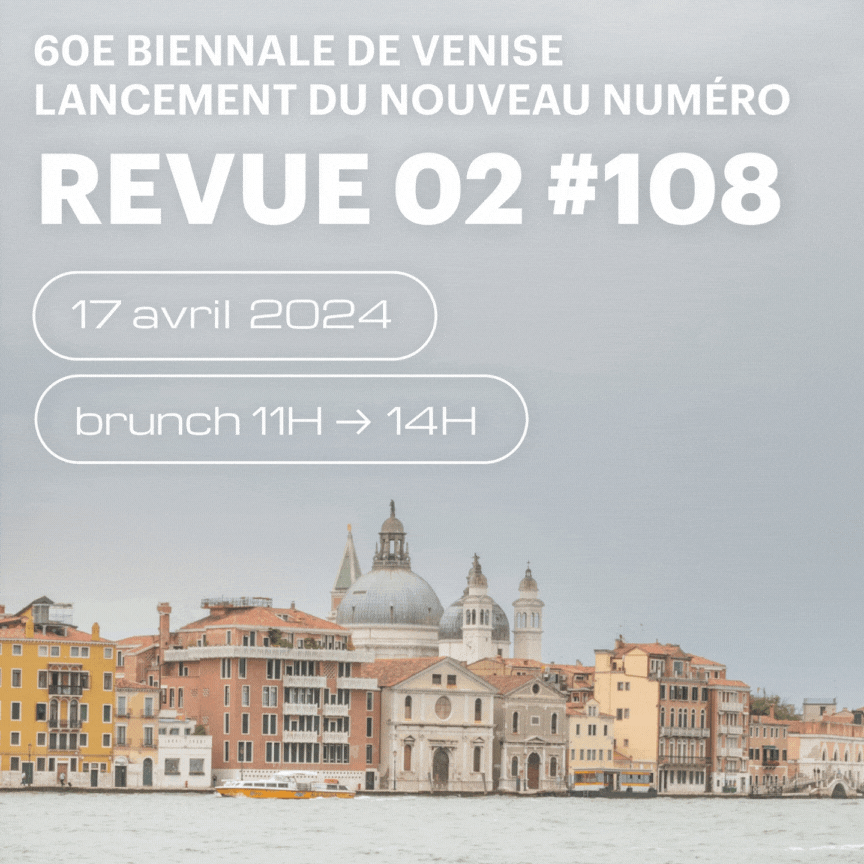Conversation avec Anri Sala

Contrairement aux apparences, il ne faut pas croire que la vidéo soit véritablement son médium : certes, Anri Sala s’est révélé à travers de courts films, il y a une bonne dizaine d’années, et continue d’exploiter l’image en mouvement avec une diabolique habileté. Mais c’est plutôt avec le temps qu’il compose, et avec la musique, qui en est la quintessence. Né en 1974 à Tirana, en Albanie, accueilli par la France qui le forme et lui offre la nationalité, l’artiste vivant désormais à Berlin a découvert le langage essentiellement dans l’exil. Comment les mots peuvent nous rendre étrangers au monde, comment la mélodie peut nous remettre, elle, en harmonie avec ce qui nous entoure : son oeuvre affine depuis cette recherche, de sa magnifique rétrospective en 2012 au Centre Pompidou à son chef-d’oeuvre de film, 1 395 Days without Red, tourné à Sarajevo sur une symphonie de Tchaïkovski, en passant par ses performances inspirées de Madame Butterfly. Musique, car c’est elle aussi qui compose notre être de souvenirs, celui que Sala cherche à mettre en vibration tout comme les lieux qu’il met en scène dans ses films et qu’il bouleverse dans ses expositions. Portée par une exceptionnelle technique du son et de sa diffusion, cette quête pourrait atteindre un de ses points d’acmé avec cette Biennale de Venise 2013 où il représente la France. Après avoir travaillé autour d’une mélodie des Clash ou d’un solo de batterie, avoir invité un saxophoniste de jazz à improviser dans son exposition à la Serpentine Gallery, c’est avec un concerto de Ravel que Sala affine à Venise son ambition : jouer du monde comme d’un instrument de musique. Maestro ?
Emmanuelle Lequeux : Comme souvent dans votre travail, votre projet vénitien est inspiré par une composition musicale. Quel rôle joue la musique dans votre rapport au monde ?
Anri Sala : Dès mon premier film, où je montrais ma mère soumise à la langue de bois caractéristique des dictatures et au déni de son passé, j’ai compris que la langue n’était pas seulement un vecteur de communication, mais aussi une force négative, un lieu de pouvoir, et en moi la syntaxe s’est cassée. On peut dire que dans mon oeuvre, la musique permet de rester dans la narration, mais sans l’encadrer, en ouvrant des significations possibles, en permettant d’aller au-delà du concept. Elle s’est substituée au verbe car elle est plus proche du souffle.
Votre proposition pour la biennale tourne autour d’un concerto de Ravel, d’où son titre : Ravel Unravel. Pourquoi ce choix ?
A.S : Tout est bâti autour du Concerto pour la main gauche de Ravel. Le compositeur l’avait imaginé à la demande de Paul Wittgenstein, frère du philosophe Ludwig, qui avait perdu un bras pendant la guerre de 14-18. Il venait d’une famille très aisée, ce qui lui a permis de commander des oeuvres à Prokofiev, à Strauss, comme à Ravel. Aujourd’hui, ce concerto intéresse beaucoup les pianistes car il est méconnu et nécessite une technique de virtuose. Pour moi c’est le meilleur de ses concertos, il est néoclassique avec des moments jazzy et marque le début de la modernité.

Anri Sala – Unravel, 2013.
Projection vidéo HD, couleur, sur deux écrans, présentés dans deux espaces distincts, son : mono (première projection) et discrete 4.0 surround (deuxième projection), durée : 20 min. 45 sec. chacun / HD video projection, colour, on 2 screens in 2 separate spaces, sound: mono (first projection) and discrete 4.0 surround (second projection), duration: 20 min. 45 sec. each.
Courtesy Galerie Chantal Crousel, Paris ; Marian Goodman Gallery, New York ; Hauser & Wirth, Zurich/London ; kurimanzutto, Mexico City. © Anri Sala.
Comment avez-vous travaillé à partir de cette composition musicale ?
A.S : Je m’intéresse beaucoup à la gestuelle du corps et, dans ce projet, j’ai cherché à rendre présente la main absente, comme un membre fantôme. Normalement, la main droite joue la mélodie et la gauche le rythme, mais là tout se renverse, avec un pouce très puissant qui doit jouer la mélodie. Tout le rapport entre les notes et le corps change, et le pianiste a un rapport différent avec les graves et les aiguës. Nous avons d’abord filmé en parallèle deux pianistes très connus, jouant sur deux instruments, chacun en lien avec son orchestre mais jouant dans des salles différentes pour être enregistrés séparément. Le montage ne montre tout d’abord que leurs mains, donnant l’illusion qu’ils ne font qu’un, filmé par deux caméras. Puis une distance se crée peu à peu entre ces deux corps, la conscience d’une différence naît. Chacun a sa propre façon de s’asseoir, de suivre la main.
Il y a cette année un échange de pavillons entre la France et l’Allemagne, vous allez donc devoir investir le pavillon allemand. Dans quelle mesure cela a-t-il eu des répercussions sur ce projet ?
A.S : J’aime placer une idée, un espace, sous l’influence du monde, pour les « mettre en fréquence » par le biais du son et de la musique, les faire entrer en vibration. Je cherche à faire jouer l’architecture, comme on le dit d’un instrument. Ravel Unravel s’est donc construit sur les qualités physiques du lieu, le projet aurait été différent s’il avait été situé dans le pavillon français : le pavillon allemand est plus vaste et surtout plus haut. La musique est pour moi une manière de prolonger la possibilité de l’architecture. Et puis cet échange entre les deux pavillons, que nous avons désiré très tôt dans le processus car nous adhérons à cette idée post-nationale, trouve certains échos symboliques dans le travail, même si ce dernier ne s’est pas construit à partir de là. Il faut se souvenir que ce concerto a été composé dans un moment de guerre très sanglante et que Ravel était un très grand pacifiste : il a par exemple beaucoup critiqué le fait que, pendant la guerre, l’on ne joue plus les grands compositeurs allemands. Et la famille Wittgenstein, qui a fait fortune dans l’aciérie, a dû quitter l’Autriche pour fuir le nazisme. Mais bien sûr, je n’ai pas choisi ce concerto pour cela…
C’est aussi votre travail monumental sur le son qui va créer le trouble. Comment avez-vous opéré à partir de ces deux mélodies ?
A.S : Cet enregistrement a créé comme un brouillard de musique dont nous avons ensuite retravaillé le tempo en studio avec un sound-designer et un compositeur, pendant de longs mois, afin de créer une complicité entre les deux enregistrements. Nous avons modifié peu à peu les rythmes des deux pianos : tout en gardant la cohérence initiale de 48, nous avons par exemple ralenti l’un à 40, accéléré l’autre à 60, en changeant constamment au fil de la partition sans que cela soit jamais disharmonique. D’où le titre qui joue sur les deux verbes anglais ravel / unravel, soit emmêler / démêler. C’est comme un travail d’architecte à partir d’une composition musicale pour amener le visiteur à une perception différente de l’espace, en faisant du son une forme sculpturale qui sera renforcée par le fait que la salle centrale où le film est projeté est an-échoïque. Ce dispositif sonore permet d’annihiler le sentiment de l’espace, qui ne se perçoit plus que dans cette différence entre les deux sons. Cela m’a toujours inspiré, ces moments de dissonance et de consonance liés à l’exil : j’ai toujours une manière de regarder en stéréo plutôt qu’en mono.
Comment les deux films sont-ils projetés dans l’espace ?
A.S : Il y a deux écrans de cinq mètres, installés l’un au-dessus de l’autre mais en léger décalage, tout comme les deux pianos ont des timbres différents, ce que l’on ne peut absolument pas modifier au mixage. Au début, on voit une main sur les deux écrans, l’une a un rapport plus physique et dynamique au piano. L’on croit qu’il s’agit d’un split-screen, de deux caméras dirigées vers une même réalité, et c’est le son qui, peu à peu, fait percevoir le décalage et l’élargit.
Autour de cette pièce centrale, vous avez aussi réalisé une vidéo, qui l’encadrera comme une parenthèse.
A.S : Nous avons tourné dans le pavillon même pour filmer DJ Chloé qui tente avec sa console de réunifier les deux pianos, en aplatissant les différences. Bref, nous avons demandé à une DJ de faire le contraire de ce qu’on lui demande d’ordinaire. La première chose que l’on voit en entrant dans le pavillon, c’est un film muet avec cette DJ que l’on ne peut entendre. Puis, dans la troisième chambre, on la voit et on l’entend. Chloé devient comme l’écho même du pavillon, elle est filmée comme si elle était vraiment face aux pianos. Mais contrairement aux pianistes, elle est dans l’anti-performance.

Anri Sala – Ravel Ravel, 2013.
Projection vidéo HD sur deux écrans, couleur, son multi-canal, durée : 20 min. 45 sec. chacun / HD video projection on 2 screens, colour, sound: multichannel, duration: 20 min. 45 sec. each.
Courtesy Galerie Chantal Crousel, Paris ; Marian Goodman Gallery, New York ; Hauser & Wirth, Zurich/London © Anri Sala
Ce jeu sur la composition de Ravel pose la question des droits d’auteur, qu’avez-vous négocié avec les descendants de Ravel ?
A.S : Ce n’est pas une réécriture de la partition, simplement une interprétation, le droit moral est donc respecté. Mais la famille nous a donné le droit de modifier les deux sources en même temps. Il est à noter un décalage intéressant entre la France et l’Allemagne d’un point de vue juridique, dû à la manière dont on compte les années de guerre : en Allemagne, Ravel est tombé dans le domaine public, ce qui n’est pas le cas en France.
Anri Sala in conversation with Emmanuelle Lequeux
Contrary to appearances, it should not be thought that video is really his medium. Certainly, Anri Sala came to notice through various short films, made a good ten years ago, and he still uses the moving image with devilish skill. But he tends rather to work with time, and its quintessence, music. The now Berlin-based artist was born in Tirana, in Albania, then settled in France, where he was educated. He now has French nationality, and discovered language essentially in exile. The way words can make us strangers in the world, and the way tunes can, for their part, put us back in harmony with the things around us: his work has since been refining this quest, from his splendid retrospective in 2012 at the Centre Pompidou to his masterpiece film 1 395 Days without Red, shot in Sarajevo on a Tchaikovsky symphony, by way of his Madame Butterfly-inspired performances. For it is music, too, which composes our being with memories, the being that Sala seeks to make vibrant, just like the places he presents in his films and turns upside down in his exhibitions. Carried along by an outstanding technique of sound and its diffusion, this quest might well reach one of its climaxes in the 2013 Venice Biennale, where he is representing France. After working around a Clash song, or a drum solo, and after inviting a jazz saxophonist to improvise at his show in London’s Serpentine Gallery, it is with a Ravel concerto that Sala is honing his ambition in Venice—an ambition to play the world like a musical instrument. Maestro?
Emmanuelle Lequeux : As often in your work, your Venetian project is inspired by a musical composition. What role does music play in your relationship to the world?
Anri Sala : With my first film, where I showed my mother suffering from the cant typical of dictatorships, and from a denial of the past, I realized that language was not only a vehicle of communication, but also a negative force, a place of power, and, in me, syntax has broken up. One might say that in my work music makes it possible to stay in the narrative, but without encircling it, by opening up possible meanings, and helping to go beyond the concept. Music has replaced words, because it’s closer to breath.
Your proposal for the Biennale focuses on a Ravel concerto, which explains its title: Ravel Unravel. Why this choice?
A.S : It’s all constructed around Ravel’s Piano Concerto for the Left Hand. He composed it at the request of Paul Wittgenstein—brother of the philosopher Ludwig—who lost an arm during the First World War. The Wittgensteins were a very well-off family, which meant that Paul could commission works from such figures as Prokofiev, Strauss, and Ravel. Nowadays this concerto interests pianists a lot, because it is little known and calls for a virtuoso technique. For me, it’s the best of his concertos—it’s neo-classical with jazzy moments, and marks the beginning of modernity.
How did you work using this musical composition as a base?
A.S : I’m very interested in body language and, in this project, I’ve tried to make the missing hand present, like a phantom limb. Normally the right hand plays the melody, and the left the rhythm, but here everything is the other way round, with a very powerful thumb that has to play the melody. The whole relation between the notes and the body changes, and the pianist has a different relation with the low notes and the high notes. First we filmed two very well-known pianists in parallel, playing on two pianos, each one associated with its orchestra, but playing in different rooms so that they could be recorded separately. To start with, the editing shows just their hands, giving the illusion that there is just one pianist, being filmed by two cameras. Then a distance is gradually created between the two bodies, and you start to become aware that there’s a difference. Each pianist has their own way of sitting, and following their hand.
This year there’s an exchange of pavilions between France and Germany, so you’ll be having to use the German pavilion. To what extent has this had repercussions on your project?
A.S : I like placing an idea, a space, under the influence of the world, to “put them on the same wavelength” by way of sound and music, and get them vibrating together. I try to play the architecture, the way one plays an instrument. So Ravel Unravel is built on the physical qualities of the place. The project would have been different if it were situated in the French pavilion: the German pavilion is larger and above all higher. Music, for me, is a way of extending the possibility of architecture. And then this exchange between the two pavilions, which we wanted very early on in the process because we go along with this post-national idea, has certain symbolic echoes in the work, even if it is not constructed from there. It’s worth remembering that this concerto was composed at a very bloody moment in the war, and that Ravel was a very committed pacifist. For example, he was very critical of the fact that, during the war, people no longer played the great German composers. And the Wittgenstein family, who made their fortune with steel, had to leave Austria to flee from Nazism. But needless to say I didn’t choose this concerto for that…

Anri Sala – Ravel Ravel, 2013.
Projection vidéo HD sur deux écrans, couleur, son multi-canal, durée : 20 min. 45 sec. chacun / HD video projection on 2 screens, colour, sound: multichannel, duration: 20 min. 45 sec. each.
Courtesy Galerie Chantal Crousel, Paris ; Marian Goodman Gallery, New York ; Hauser & Wirth, Zurich/London © Anri Sala
Your monumental work on sound is also going to create confusion. How did you work on the basis of these two melodies?
A.S : This recording created something akin to a fog of music, whose tempo we then re-worked in the studio with a sound designer and a composer, over many months, in order to create a complicity between the two recordings. We gradually altered the rhythms of the two pianos. While keeping the initial coherence of 48, we for example slowed one down to 40 and speeded the other up to 60, changing all the time through the score, but without it ever being disharmonious. Which explains the title which plays on the two English verbs, to ravel and to unravel. It’s like an architect’s work based on a musical composition to bring the visitor to a different perception of space, turning sound into a sculptural form that will be heightened by the fact that the central room where the film is screened is anechoic. This sound system makes it possible to do away with the feeling of space, which is now only perceived in this difference between the two sounds. This has always inspired me, these moments of dissonance and consonance associated with exile: the way I see things is always in stereo rather than mono.
How are the two films projected in space?
A.S : There are two 5 metre screens, installed one above the other, but slightly offset. Just like the two pianos have different tones, which is something it’s absolutely impossible to alter in the mixing. To start with, you see a hand on the two screens, one has a more physical and dynamic relation to the piano. You think it’s a split screen, with two cameras aimed at one and the same reality, and it’s the sound which, little by little, lets you see the slight discrepancy and makes the gap bigger.
Around this central piece you’ve also made a video, which will frame it like a parenthesis.
A.S : We shot in the actual pavilion to film DJ Chloé trying with her console to bring the two pianos back together, by flattening out the differences. In a word, we asked a DJ to do the opposite to what is usually asked of DJs. The first thing you see when you walk into the pavilion is a silent film with this DJ, and you don’t hear what she’s up to. Then in the third room you see and hear her. Chloé becomes like the actual echo of the pavilion. She’s filmed as if she were really looking at the pianos. But unlike the pianists, she’s in the anti-performance.
This interplay on Ravel’s composition raises the issue of royalties. What did you negotiate with Ravel’s heirs?
A.S : It’s not a re-write of the score, just an interpretation, so the moral rights are respected. But the family has given us the right to modify the two sources at the same time. It’s worth noting that there’s an interesting difference between France and Germany, from a legal angle, due to the way the war years are reckoned. In Germany, Ravel is in the public domain, which isn’t the case in France.
- Partage : ,
- Du même auteur : [Écritures documentaire] Jean-Pierre Rehm,
articles liés
Anna Longo
par Clémence Agnez
Anne-Claire Duprat
par Vanessa Morisset
Entretien avec Katerina Gregos
par Anna Kerekes


